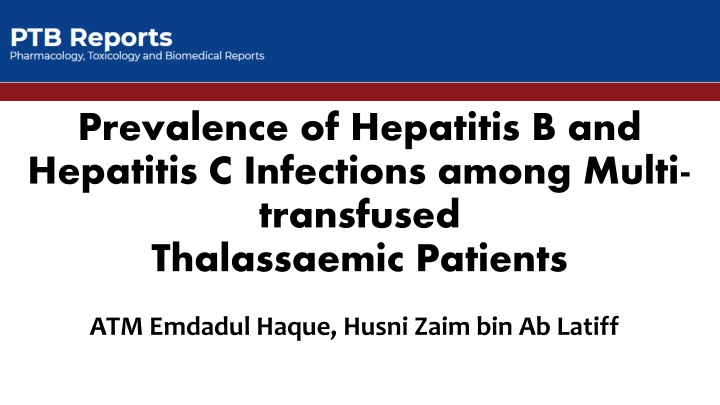
Prevalence of Hepatitis B and Hepatitis C among Multi-transfused Thalassaemic Patients
Explore the prevalence of Hepatitis B and Hepatitis C infections among multi-transfused Thalassaemic patients. The study reveals significant insights into the occurrence of viral hepatitis within this patient group, emphasizing the importance of blood screening and healthcare provider awareness in preventing associated risks.
Download Presentation

Please find below an Image/Link to download the presentation.
The content on the website is provided AS IS for your information and personal use only. It may not be sold, licensed, or shared on other websites without obtaining consent from the author. If you encounter any issues during the download, it is possible that the publisher has removed the file from their server.
You are allowed to download the files provided on this website for personal or commercial use, subject to the condition that they are used lawfully. All files are the property of their respective owners.
The content on the website is provided AS IS for your information and personal use only. It may not be sold, licensed, or shared on other websites without obtaining consent from the author.
E N D
Presentation Transcript
Prevalence of Hepatitis B and Hepatitis C Infections among Multi- transfused Thalassaemic Patients ATM Emdadul Haque, Husni Zaim bin Ab Latiff
Objective: Therefore this study was aimed to determine the prevalence of Hepatitis B and C infections among the multi-transfused Thalassaemic patients. Methodology: The medical records of total 100 patients with thalassaemia attending the Day Care Ambulatory Unit for blood transfusion in Raja Permaisuri Bainun Hospital was collected in order to extract relevant information pertaining to the study
Results: Among the 100 multi-transfused thalassaemic patients, 48% were females and 52% were males. 24% was infected with viral hepatitis, among them 18% by Hepatitis C, 4% by Hepatitis B, and only 2% were infected by both Hepatitis B & C. Difference in occurrence of hepatitis in different gender groups was not significant, on the other hand difference in occurrence of hepatitis in different ethnic groups was highly significant. Discussion and Conclusion: Acquisition of hepatitis C as well as hepatitis B is a serious risk for multi-transfused thalassaemia patients. Blood screening in Malaysia has significantly reduced the risk of hepatitis B and C associated with blood transfusion. However, the risk is still there. So, the health care providers who are involved with the management and providing blood transfusion to the thalassaemic patients should be aware of this problem, and should pay more attention to prevent these known complications.
KEYWORDS Blood transfusion, Hepatitis B, Hepatitis C, Thalassemia.
The acquisition of Hepatitis C as well as Hepatitis B is still a serious risk for multi-transfused patients in the Day Care Centre, Thalassaemia Unit, Raja Permaisuri Bainun Hospital. Blood screening initiated in 1995 in Malaysia has been known as a main factor that has significantly reduced the risk of transfusion related hepatitis B and C. However, the risk is still there. So, the health care providers who are involved in the management and blood transfusion of thalassaemic patients should be more aware of this problem, and pay more attention to prevent these known complications.
